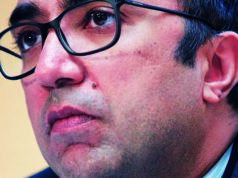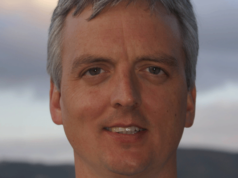
Juan F Granada (president and CEO, Cardiovascular Research Foundation, New York, USA) wanted to be a physician from a young age and fell in love with interventional cardiology when he saw balloon angioplasty performed. He talks to Cardiovascular News about his career mentors, why physicians can play a pivotal role in developing novel technologies, and why this year’s Transcatheter Cardiovascular Therapeutics (TCT) meeting (21–25 September, San Diego, USA) is a “training destination”.
Why did you decide to become a doctor and why, in particular, did you decide to go into interventional cardiology?
Some people take a while to decide what they want to do in life. I was very lucky because I always knew what I wanted to do from a very early age. I always wanted to be a cardiac surgeon—I am not very sure where that desire came from (no one in my family was a doctor)!
What is interesting is that I have also always wanted to work in cardiology. For some reason, I was attracted to the heart. After medical school and after doing my one-year social service (as is required in Colombia), I worked as a research fellow at a cath lab in Colombia. I saw them to perform a complex balloon angioplasty case and fell in love with it; I thought, “this is what I want to do!”.
Who have been your career mentors?
My first mentor and the person who really opened the doors for me was Humberto J Vidaillet (Department of Cardiology, Marshfield Clinic, University of Wisconsin Medical School, Madison, USA). He was the person who brought me to the USA, gave me my first opportunities, and essentially taught me valuable lessons about North American culture. He is the reason I am in the USA.
After that, when I went to Houston for my cardiology and interventional cardiology training, there was Michael DeBakey, he was truly an inspirational figure. This was an extremely exciting time in my career because I was able to work with amazing people in the cardiology field. For example, Drs Michael Raizner and Neil Kleiman (both Houston Medical Center, Houston, USA) helped shape my career as an interventional cardiologist and provided an amazing platform for me to go into translational research.
Martin Leon has shaped the last 10 years; he has been a true mentor to me and gave me all the tools that I needed to do what I wanted to do at the Cardiovascular Research Foundation (CRF). He has been influential and an important part of my career.
You did your initial medical training in Colombia before moving to the USA. What are the key differences in healthcare between Colombia and the USA?
There are significant differences. One thing is that Colombia has universal coverage in contrast to the USA, but universal coverage does not necessarily mean that everyone has equal opportunities to access technology and devices. There are also differences between Colombia and USA in terms of how much money can be invested into healthcare.
I do really believe that the universal coverage system in Colombia works though. No matter where people are and what access they have to some technologies, there is at least a certain level of equal access to healthcare for everyone—this is sometimes lacking in the USA.
What has been the most important development in interventional cardiology during your career?
For me, it is difficult to pick one specific development. Due to the nature of my work, I have been fortunate to witness significant success stories in our field. But, I always saw the introduction of the stent as what made interventional cardiology a viable specialty. Following the introduction of the drug eluting stent, we had—for the first time—a therapeutic tool showing sustained efficacy; I do not think that bare metal stents alone would have allowed interventional cardiology to become the alive and vibrant field that it is now. Also, I think that some of the new interventional therapies introduced to date such as transcatheter aortic valve implantation (TAVI) owe its success to the engineering and clinical know-how gained during the era of drug-eluting stents.
As someone who has always been interested in innovation, where do you think the next “breakthrough” will be in interventional cardiology?
Innovation in our field has rapidly moved into the so-called structural heart disease space, which seems to be the “next revolution” in our field. I think eventually all these technologies will offer surgical-like devices with the use of catheter-based techniques. Both repair and replacement devices will be available and, unlike the surgical field, device “ease of use” will play a major role in physicians’ adoption and use. I am very intrigued though about the next wave of innovation in our field; I really think that computer power and data analytics are going to open exciting opportunities for the development of new technologies in our field.
Why is it valuable for an interventional cardiologist, such as yourself, to be involved with developing new technologies?
I think the physician plays a vital role in the innovation ecosystem. You cannot invent anything meaningful in medicine if you do not understand the need or the problem. Every physician is a potential inventor—they see the challenges and the possible solutions. In fact, I would say that physicians are the first and perhaps one of the critical components of the innovation cycle.
You were previously executive director of the CRF Skirball Center for Innovation. What does the centre do?
The centre is dedicated to the research and validation of early stage technologies. We have created a platform that fosters innovation by allowing the collaboration and interaction between inventors, start-up companies, and established companies.
 You were appointed as president and CEO of CRF in September 2017. What are your key duties?
You were appointed as president and CEO of CRF in September 2017. What are your key duties?
At CRF, we have four main divisions (CRF Skirball Center for Innovation, CRF Clinical Trials Center, CRF Center for Education and the newly-established CRF Digital). So, I have a full plate of things to do because I have to oversee the strategy of these four divisions. I combine this work with my research at the Skirball Center and try to keep my interventional skills sharp!
Given that information is increasingly available online, and the current cost pressures of attending conferences, what do you think the value is of still attending meetings?
There is no doubt that the environment is changing and that it is changing on multiple levels. But, I really believe meetings are absolutely necessary and critical to learning about new techniques and technologies. Through a computer screen, you cannot teach technique, have close mentor-derived discussions, or network.
Therefore, I think meetings should focus on practical and hands-on training to be able to fulfil the needs of the physicians in these times when so much information is online. This is what the future of TCT will focus on.
What do you think the highlights of this year’s TCT will be?
We have made significant changes to the programme; the number of didactic lectures have decreased by a significant percentage to allow the development of what we are calling a “training pavilion”. We are going to have a large space in which we are going to have eight dedicated tracks for practical training. This will include hands-on skills training, case-based learning led by key opinion leaders, and discussions about new technologies. This is why, this year, we are calling TCT the “training destination”.
What advice would you give to someone who is just coming into the profession?
The first thing that I tell my fellows is “make sure you love what you do” because interventional cardiology is a very intense specialty that is going to require a lot of devotion, time, and love. Obviously, I am biased because of my interest in innovation, but I also tell people that they should never lose their spirit of invention—being involved in seeing what the needs are and developing new technologies as a result is what makes this field fun and different.
Finally, I would advise that people look at new areas that actually have never been explored before. For example, interventional heart failure is novel field—we will sure monitor and manage heart failure patients in different ways in the future. There are several amazing new fields that can be led by the next generation of interventional cardiologists.
Outside of medicine, what are your hobbies and interests?
I am a football [soccer] aficionado; it has always been big in my life. I learned the sport on the streets of Colombia and I have learnt valuable lessons from it— such as the importance of training, teamwork and dedication. I still play with the Colombian physicians’ national team and I try to go to the World Medical Football Championship every year.
I am also passionate for the history of science and invention, even beyond the medical field. Finally, I would not say I am formal chef, but I like to think I am a good cook! Food and cooking is one of my passions. I cook everything!
Current appointments
- September 2017—present: President & CEO, Cardiovascular Research Foundation, Columbia University Medical Center, New York, USA
- July 2015–present: Associate Professor of Medicine, Columbia University Irving Medical Center, New York Presbyterian Hospital, New York, USA
- July 2015—present: Interventional cardiologist, New York Presbyterian Hospital, New York, New York, USA
- January 2013–present: Co-Director, TCT meeting
Medical education
- July 2004–June 2005: Interventional cardiology fellow, Baylor College of Medicine, Houston, USA
- July 2001—June 2004: Fellow in Cardiovascular Diseases, Baylor College of Medicine, Houston, USA
- July 1999—June 2001: Chief resident in Medicine, University of Wisconsin, Marshfield Clinic, Marshfield, USA
- July 1998—June 1999: Internship, University of Wisconsin, Marshfield Clinic, Marshfield, USA
- January 1995–December 1997: Research fellow in Interventional Cardiology, St Mary’s Cardiovascular Hospital, Medellin, Colombia
- January 1993—December 1994: Internship, Medellin General Hospital, Medellin, Colombia
Achievements
- Young Investigator Award, American College of Cardiology (2008)
- The James T Willerson Vulnerable Plaque Young Investigator Award for Basic Research, American Heart Association (2002)
- The Outstanding Young Persons of the World Award (TOYP) (2001)
- Young Investigator Award, American College of Cardiology (2000)
- More than 20 patent applications in the medical device technology field













